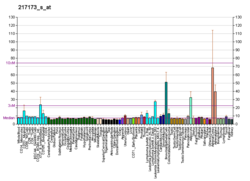|
| LDLR |
|---|
 | | | Structures disponibles |
|---|
| PDB | Recherche d'orthologue: PDBe RCSB |
|---|
| Identifiants PDB |
|---|
1AJJ, 1D2J, 1F5Y, 1HJ7, 1HZ8, 1I0U, 1IJQ, 1LDL, 1LDR, 1N7D, 1XFE, 2FCW, 2KRI, 2LGP, 2W2M, 2W2N, 2W2O, 2W2P, 2W2Q, 3BPS, 3GCW, 3GCX, 3M0C, 3SO6, 2M7P, 2MG9, 3P5B, 3P5C, 4NE9 |
|
| | Identifiants |
|---|
| Aliases | LDLR |
|---|
| IDs externes | OMIM: 606945 MGI: 96765 HomoloGene: 55469 GeneCards: LDLR |
|---|
| | | | | | Wikidata | |
Le LDLR ou récepteur des LDL est une protéine dont le gène est le LDLR situé sur le chromosome 19 humain[5]. Les travaux de Joseph Goldstein et de Michael Brown sur ce récepteur leur ont valu le prix Nobel de physiologie ou médecine en 1985.
Structure et rôles
Il s'agit d'une glycoprotéine faisant 164 Kdaltons[6].
Le PCSK9 favorise la dégradation de cette protéine, entraînant un ralentissement de celle du LDL cholestérol et une augmentation du taux sanguin de ce dernier[7].
En médecine
Différentes mutations du gène provoquent une hypercholestérolémie familiale[8]. Près de 1200 variants ont été identifiés, dont 80 % ayant des conséquences sur le taux de cholestérol[9].
Les médicaments de type anti-PCSK9 augmentent le taux de LDLR, favorisant la dégradation du LDL cholestérol et abaissant le taux sanguin de ces derniers.
Notes et références
- ↑ a b et c GRCh38: Ensembl release 89: ENSG00000130164 - Ensembl, May 2017
- ↑ a b et c GRCm38: Ensembl release 89: ENSMUSG00000032193 - Ensembl, May 2017
- ↑ « Publications PubMed pour l'Homme », sur National Center for Biotechnology Information, U.S. National Library of Medicine
- ↑ « Publications PubMed pour la Souris », sur National Center for Biotechnology Information, U.S. National Library of Medicine
- ↑ Lindgren V, Luskey KL, Russell DW, Francke U, Human genes involved in cholesterol metabolism: chromosomal mapping of the loci for the low density lipoprotein receptor and 3-hydroxy-3-methylglutaryl-coenzyme A reductase with cDNA probes, Proc Natl Acad Sci U S A, 1985;82:8567–8571
- ↑ Schneider WJ, Beisiegel U, Goldstein JL, Brown MS, Purification of the low density lipoprotein receptor, an acidic glycoprotein of 164,000 molecular weight, J Biol Chem, 1982;257:2664–2673
- ↑ Maxwell KN, Breslow JL, « Adenoviral-mediated expression of Pcsk9 in mice results in a low-density lipoprotein receptor knockout phenotype », Proc Natl Acad Sci U S A, 2004;101:7100-7105
- ↑ Hobbs HH, Brown MS, Goldstein JL, Molecular genetics of the LDL receptor gene in familial hypercholesterolemia, Hum Mutat, 1992;1:445–466
- ↑ Usifo E, Leigh SE, Whittall RA et al. Low-density lipoprotein receptor gene familial hypercholesterolemia variant database: update and pathological assessment, Ann Hum Genet, 2012;76:387–401
|







